Mexican People from the Land of Pluma Mountain Oaxaca Coffee who Have Made History
Dear coffee lovers and lovers of Mexican culture, we dedicate this post to the great leaders, inspiring people, female artists and artists who have Oaxacan roots and have had an important contribution to Mexican history and culture. For Mexico Real Cafe it is an honour to write about these Mexican people who are descendants from the land where our Pluma Mountan Oaxaca Coffee is grown.
All of these people have in common their great spirits, perseverance, passion, and warrior spirit in different areas.
They have dedicated their lives and efforts to pursuing their dreams and, as they have loved what they have done, they have achieved recognition in different areas.
Oaxaca is a land full of traditions and ancient wise cultures which have inspired Oaxacan people to achieve great dreams.
Some of these Oaxacan people were presidents of the country, some others have followed an illustrious military career and defended the country from foreign invasions, others have been artists who have brought Mexican and Oaxacan cultures to international audiences.
There were others who were diplomats who have played a key role in Mexican history. Overall, these people’s love for both the land where they were born, and culture; are present in their life and legacy.
Let’s start our journey in the Mexican history to know a bit more about this illustrious people of Oaxacan’s roots.
* Benito Juarez Garcia:
Benito Juarez was born in Oaxaca in 1806. He was one of the most influential presidents of the country and has been immortalized in Mexico’s history as a hero. For these reasons Oaxaca has adopted the name of Oaxaca de Juarez to honour him.
Benito Juarez, who was of Zapotec origin, was also the first indigenous President of the country. This event was historic in Mexico and brought hope to the recent independent country (no longer a Spanish colony).
Mexico got its independence from Spain in 1821 after the Mexican War of Independence. However, after getting its independence the presidents of Mexico continued to be of Spanish descent until Benito Juarez became president of Mexico in 1858.
Because of his bright mind, when Benito Juarez was a child, he was accepted in a seminary and educated there. Thanks to his education, Benito Juarez could read fluently in Latin and French and had access to books coming from Europe.
Juarez had a bright intelligence but did not feel a calling to become a priest, thus he started his studies in law at the Institute of Sciences and Arts in Oaxaca of which he also became a well known Professor.
As a lawyer and politician Benito Juarez was inspired by the liberal philosophy of the French revolution and its constitution. For this reason Benito Juarez as the president of Mexico sought constitutional reforms in the new born independent country of Mexico to create a democratic federal republic.

Overall, Benito Juarez is a hero in the Mexican culture because of his political success and ability to lead the country through difficult times.
* Porfirio Diaz Mori:
Diaz was born in Oaxaca in 1830 and passed away in Paris. He was a mestizo President: half Mixtec from his mother’s side and half Spanish descent from his father’s side. Porfirio Diaz’s father was a colonel and fought in the troops to get independence from Spain.
Porfirio Diaz was a well educated president of the new born and independent country of Mexico. Diaz was accepted in the seminary and was fluent in Latin but, inspired by the President Benito Juarez, he quit the seminary and studied law.
Diaz also became a law professor in The Institute of Sciences and Arts in Oaxaca but left that position to follow his military and political career.
In his military career and serving during Benito’s Juarez government, Díaz rose to the rank of General and led Mexican troops against the French invasion and imposed rule of Emperor Maximilian.
Diaz played a key military role during this war. Thanks to his skills and military strategies, the Mexican troops were victorious and defeated the French troops of Napoleon III, which was one of the most renowned, powerful and skilled military troops in the world.

The Porfiriato (the period from 1876 to 1911, during which Diaz was president of the country), was indeed a time marked by major changes in the country.
Though during his government there were many important technological advances in the country, this period was also marked by economic inequality.
An interesting fact is that though Porfirio Diaz fought against the French troops, he highly appreciated the French culture. During the Porfiriato, Mexico city became gradually a little Paris. This was a period of modernization characterized by a French influence.
Important buildings of French influence like the Palace of Fine Arts, The Postal Palace, the Angel of Independence Monument, the Palace of Communications, the Juarez Theater, The Revolution Monument , Plaza Manuel Tolsá, The Expiatory Temple, The Old Maritime Customs Building of Tampico, among others, were built during this period.
* Matias Romero Avendaño:
Matias Romero was born in Oaxaca City in 1837. He was a well known lawyer who has made history as one of the most influential Mexican politicians, diplomats and economic advisers.
Romero was very brilliant and started his career when he was in his twenties. During his political and diplomatic, career Romero served three times as Secretary of Finance and twice as ambassador of Mexico to the United States during the Liberal government of Benito Juarez and Porfirio Diaz in the 19th century.
Matias Romero has had a very important contribution to the economic development of the country. He was responsible for the influx of foreign investment to build railroads and bridges and to irrigate fields in Mexico.
Romero was also a coffee lover and coffee grower. Because Romero travelled frequently to Oaxaca and Chiapas, he knew well the region where the best Mexican arabica coffee is grown, and as expert in arabica coffee, he wrote a monography about arabica coffee and the traditional coffee growers.
Matias Romero was one of the first coffee growers from Oaxaca who made efforts to position Mexican arabica coffee internationally.
* Rufino Arellanes Tamayo:
Rufino Tamayo, who was one of the first Mexican painters and muralists recognized internationally, was born in Oaxaca City in 1899. His father was of Spanish descent and his mother was of Mixtec descent from Tlaxiaco, a little town in the Mixtec region.
From 1921–26, Tamayo became head of the department of ethnographic drawing at the National Museum of Archaeology in Mexico City, where he developed an interest in pre-Columbian art.
As an artist Tamayo spent many years of his career in New York City where he was influenced by European artists such as Pablo Picasso (Spanish), Georges Braque (French), and Henri Matisse (French). Due to this artistic influence and his interest in Mexican culture, Tamayo combined modern European painting styles such as Cubism and Surrealism with Mexican folk themes.
Tamayo used vivid colours and textured surfaces to depict subjects in symbolic, stylized, or semiabstract modes. He was mainly interested in transmitting emotions through colours and shapes, and creating monumental figures.
Some of Tamayo’s most important murals are “Duality” at the National Museum of Anthropology and “The Birth of Nationality” at National Institute of Fine Arts.

Tamayo has made history as one of the first Mexican artists to get international recognition with his painting artwork. He is internationally recognized as one of the most influential Mexican easel painters and muralists.
Tamayo’s artwork has been exhibited in the USA (New York), France (Paris), Italy (Venice) and Mexico. Most of Tamayo’s artworks are held in the collections of The Museum of Modern Art in New York, the Art Institute of Chicago, and the Walker Art Center in Minneapolis.
Tamayo also founded the Tamayo Contemporary Art Museum in Mexico City and the Museum of Rufino Tamayo in Oaxaca City.
* Frida Kahlo Calderón:
Frida Kahlo who was born in 1907, is one of the most important female Mexican artists.
Kahlo’s paintings and her cultural legacy are well known in Europe, The United States and Latin America.
We are proud to say that Frida Kahlo has Oaxacan roots. Frida Kahlo of Zapotec descent on her mother side. Kahlo’s grandfather on her mother side was indigenous Zapotec. For this reason she got inspiration from the Zapotec culture and she portrayed herself wearing the traditional dress of Tehuana women to represent her Zapotec culture, of which she was proud.

* Francisco Lopez Toledo:
Francisco Lopez Toledo who is most well known as Francisco Toledo, is a Mexican painter, sculptor, and graphic artist of Zapotec roots. Toledo was born in 1940 in Juchitán, Oaxaca in the Isthmus of Tehuantepec.
The pre-Hispanic world and his Zapotec roots have been his main source of inspiration. In 1960, the artist moved to Paris where he produced prints in the studio of Stanley William Hayter (a British artist who founded in Paris the most influential print workshop of the 20th century) where Toledo got his hallmark aesthetic.
Retuning to Mexico in 1965, Francisco Toledo began producing works that address his Zapotec heritage. Toledo’s paintings are a combination of the Mexican mythology and surrealist influence.

Toledo’s artwork has been exhibited in Spain, the United Kingdom, Belgium, France, Japan, Sweden, the United States (Texas), and other countries.
* Lila Downs Sanchez:
Lila Downs is a Mexican singer, songwriter and actress who incorporates indigenous Mexican influences and has recorded songs in many indigenous languages such as Mixtec, Zapotec and Mayan.
She was born in Tlaxiaco, a little town in the Mixtec region in 1968. On her mother’s side, Lila Downs has both Mixtec and Zapotec roots. On her father’s side she is American.
Lila Downs achieved commercial success and international recognition with the album La Sandunga, which was inspired by the Zapotec culture.

Lila Downs’s music has today achieved international popularity in countries such as Mexico, the United States, Spain, France, England and Germany.
* Susana Harp Iturribarría:
Susana Harp is a singer of traditional music who was born in Oaxaca city in 1968. She has Oaxacan roots from her mother’s side and Lebanese roots from her father’s side.
Susana Harp is a well known artist who sings traditional music from Oaxaca and has recorded prehispanic and contemporary music in Zapotec, Mixtec, Nahuatl and Spanish.
Through her NGO, Susana Harp has supported various indigenous cultural projects in Oaxaca. Susana Harp has also performed and promoted traditional Mexican music in major venues in Mexico, America and Europe.

Susana’s father Alfredo Harp Helú also loves the cultural heritage of Oaxaca: he adopted the Oaxacan culture since his childhood when he arrived to Oaxaca.
Today, Alfredo Harp through his NGO supports several large investment projects in education, health, culture, and conservation in the state of Oaxaca.
This was a brief presentation of the life and achievements of the illustrious people of Oaxacan roots that have had an important contribution to Mexican history and culture. From all of us at Mexico Real Cafe, we hope you have enjoyed reading about them.
We invite you to continue visiting Mexico Real’s Blog and read the posts we have written for you. Our posts cover various topics about Mexican culture and its various expressions such as: Mexican Cuisine, the Celebration of the Day of the Dead, The Mayan Culture, the Life of Frida Kahlo, Diego Rivera’s Paintings, The Love Story of Donaji and Nucano, Tehuana Women From Oaxaca Inspiration of Frida Kahlo.
You will also find coffee recipes like: Tequila coffee, Irish coffee, Cafe de Olla (Mexican Style Coffee), Espresso Martini Coffee, interesting coffee facts, the health benefits of coffee, and much more.




